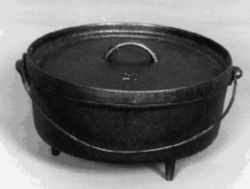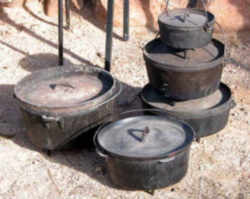
Arkansas Symbols
Arkansas State Historic Cooking Vessel
Dutch oven

Adopted in 2001.
In the 2001 regular session of the Eighty-third General Assembly of the State of Arkansas, Senator Joseph K. Mahony, II introduced Senate Bill 402 to designate the Dutch oven as the official state historic cooking vessel. The Senate and the House approved the bill. It became Act 476 of 2001 and was signed by Governor Mike Huckabee on February 28, 2001.
The Dutch oven was adopted as the state historic cooking vessel to indicate the significance of the vessel in the Arkansas's history. Dutch ovens were brought into the state by the explorers and early settlers and were in wide use by the early 1800s. By the time of statehood, most homes probably had Dutch ovens in use on their fireplaces.
Arkansas State Historic Cooking
Vessel:
Dutch oven

The Dutch oven is neither a pot nor a kettle. It is a cast iron vessel that has three legs to provide stable support and to provide space under the oven for coals to heat the oven from the bottom. The oven has a flat bottom and a tight-fitting lid to contain the heated pressure in the oven; the lid can be removed during cooking to observe or care for the cooking food. The oven has ears on two opposite places on the top of the sides, which allow it to be lifted by a bail or hooks. The sides of the oven usually have vertical walls with a smaller diameter at the bottom than the top. The lid has a rim around the edge to hold coals for additional heat.
According to Ragsdale the name Dutch Oven has been applied to a variety of cooking pots, kettles, and ovens over the years. The origin of the name, "Dutch Oven", is uncertain but Ragsdale suggests a few theories.
- In 1704 a man by the name of Abraham Darby traveled from England to Holland to inspect a Dutch casting process by which brass vessels where cast in dry sand molds. Upon returning to England Darby experimented with the process and eventually patented a casting process using a better type of molding sand as well as a process of baking the mold to improve casting smoothness. Darby eventually began casting pots and shipping them to the new colonies and throughout the world. Ragsdale suggests that the name "Dutch Oven" may have derived from the original Dutch process for casting metal pots.
- Others have suggested that early Dutch traders or salesmen peddling cast iron pots may have given rise to the name "Dutch Oven".
- Still others believe that the name came from Dutch settlers in the Pennsylvania area who used similar cast iron pots or kettles.
To this day the name "Dutch Oven" is applied to various cast pots or kettles. The most common application of the name is to a cast iron pot or kettle with a flat bottom having three legs to hold the oven above the coals, flat sides and a flat, flanged lid for holding coals. These ovens have a steel bail handle attached to "ears" on each side of the oven near the top for carrying.
Arkansas Law
The law designating Dutch oven as the official Arkansas state historic cooking vessel is found in the Arkansas Code, Title 1, Chapter 4, Section 1-4-125.
Title 1 - General Provisions
Chapter 4 - State Symbols, Motto, Etc.
§ 1-4-125 - State historic cooking vessel.
Universal Citation: AR Code § 1-4-125 (2012)
The Dutch oven is designated as the official historic cooking vessel of the State of Arkansas.

List Official US State Foods






